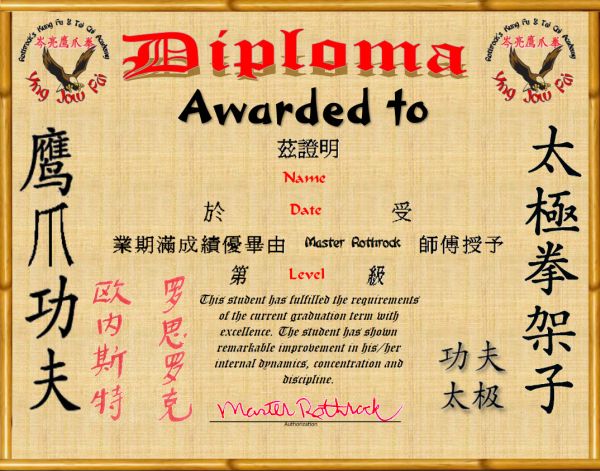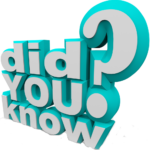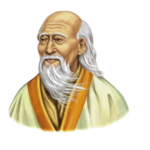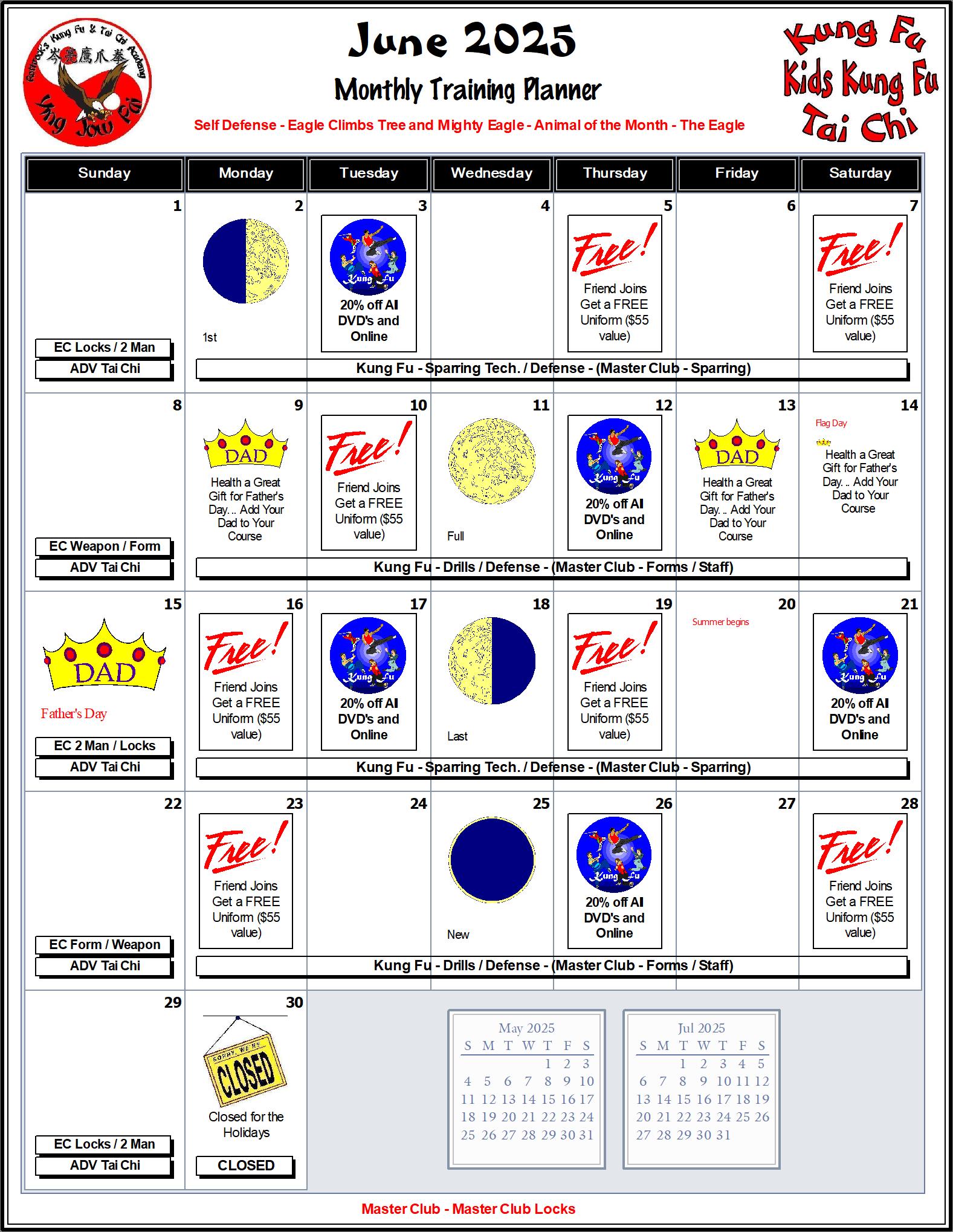Monthly Newsletter
My Promise to You! You will love every minute of your experience at the Academy. My friendly and professional staff will keep you motivated and work with you one-on-one so you never feel out of place or uncomfortable.
Table of Contents
Master's Notepad
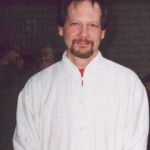
June is Father's Day. Have your Father try something different to keep them healthy: Kung Fu or Tai Chi. We have a great Web Special that is 6 weeks for $179. BUT WAIT! USE PROMO CODE: 20off AND SAVE $20. Just go to RothrocksKungFu.com/Mydad.
About Father's Day
Father's Day is a celebration honoring fathers and celebrating fatherhood, paternal bonds, and the influence of fathers in society. It has been celebrated on March 19 in Catholic Europe since the Middle Ages. This celebration was brought by the Spanish and Portuguese to Latin America, where March 19 is often still used for it, though many countries in Europe and the Americas have adopted the U.S. date, the third Sunday of June. It is celebrated on various days in many parts of the world, most commonly in March, April, and June. It complements similar celebrations honoring family members, such as Mother's Day, Siblings Day, and Grandparents Day.
“You cannot start the next chapter of your life if you keep re-reading the last one.”
Keep Training,
Master Rothrock
Remember, every Facebook check-in is a step towards more rewards. Just by checking in, you can earn 5 Points added to your Loyalty Card.
“If you get tired, learn to rest, not to quit"
Keep Training,
Master Rothrock
Kid's Corner

Animal of the Month - The Eagle (Ying Jow)
Today's Eagle Claw descends directly from three systems of Northern Kung Fu, the first of which is Chin'na (joint locking), developed by the famous General Yueh Fei (1103 - 41) of the Sung Dynasty. Although not himself a product of the Shaolin Temple, General Yueh Fei was extensively trained by the Shaolin Priest Jao Tung.
During the Ming Dynasty (1368 - 1644), a Shaolin martial monk, Li Chun, was famous for his ability to perform Faan Tzu (martial tumbling) during a significant period of Chinese cultural history. Li Chun chanced upon a demonstration of General Yueh Feii's Chin'na. Li Chun saw the power of Eagle Claw hand techniques and the beauty of the form and was determined to combine it with his own Faan Tzu. In time, the monk Li Chun combined the two systems, creating Northern Shaolin Ying Jow Faan Tzu. (Eagle Claw as we know it today.)
Eagle Claw moves must be quick, alive, and natural. If training is unnatural, arms and legs are stiff, and moves are wooden. This is what is called "dead" strength. If arms and legs are stiff, the blood and chi are in turmoil, and internal power cannot be generated. Without inner power when fighting, chances are, one will lose the fight. Eagle Claw develops natural, concentrated movements using circles and a half-clenched hand to grab, lock, and press vital points.
Eagle Claw Principles
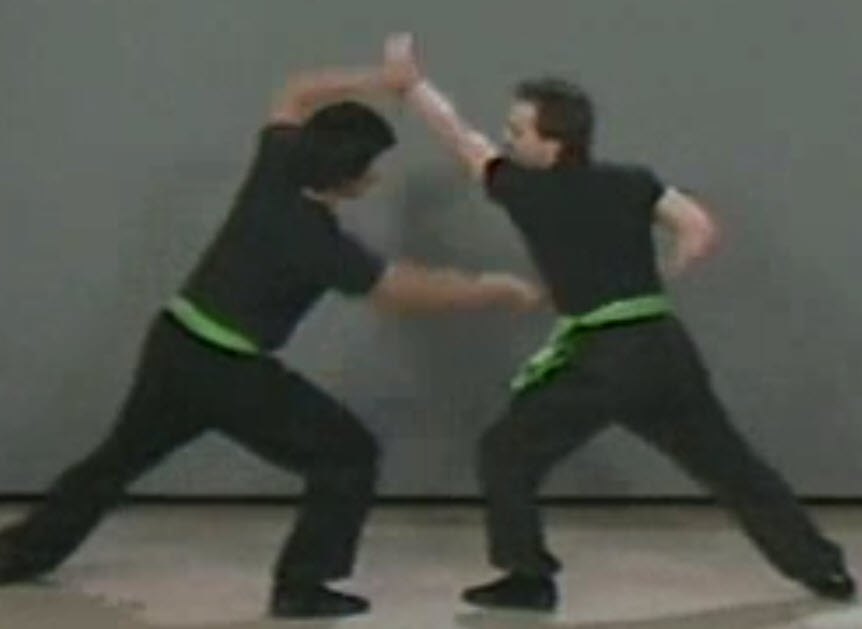
Today's Eagle Claw descends directly from three systems of Northern Kung Fu. The first of these was Chin'na (joint locking), developed by the famous General Yueh Fei (1103 - 41) of the Sung Dynasty. Although General Yueh Fei was not himself a product of the Shaolin Temple, he was extensively trained by the Shaolin Priest Jao Tung.
During the Ming Dynasty (1368 - 1644), a Shaolin martial monk, Li Chun, was famous for his ability to perform Faan Tzu (martial tumbling) during a significant period of Chinese cultural history. Li Chun chanced upon a demonstration of General Yueh Fei's Chin'na. Li Chun saw the power of Eagle Claw hand techniques and the beauty of the form and was determined to combine it with his own Faan Tzu. In time, the monk Li Chun combined the two systems, creating Northern Shaolin Ying Jow Faan Tzu. (Eagle Claw as we know it today.)
Eagle Claw moves must be quick, alive, and natural. If training is unnatural, arms and legs are stiff, and moves are wooden. This is what is called "dead" strength. If arms and legs are stiff, the blood and chi are in turmoil, and internal power cannot be generated. Without internal power when fighting, chances are, one will lose the fight. Eagle Claw develops natural, concentrated movements using circles and a half-clenched hand to grab, lock, and press vital points.
Eagle Claw exercises power like the bird that inspires the system—short, sharp, and fast. As will be illustrated further, the hand techniques are dominated by the use of the claw and the seven principles. The movements must be light and hard together.
Eagle Claw's wrists and fingers are special, and they should be developed so that Eagle Claw can control an opponent without injury and cause damage only when absolutely unavoidable.
Eagle Claw comprises 7 principles for developing your self-defense and Kung Fu skills. Eagle Claw is considered the jewel of Kung Fu and is a complete system. The principles include:
1. Jow Da, Cum Na uses the fingers to claw and grab and lock the opponent so they cannot move.
2. Fun Gun, Chaw Quat to twist and separate muscles and tendons, and break bones.
3. Dim Yut, Bye Hei strikes the vital points with the fingers and uses the Eagle Claw to stop blood flow and breathing.
4. Cow Wai, Saw Fung presses the arm to break, lock, and control the opponent with fast, smooth blocks.
5. Sim Jim, Tong Na uses twisting body movements with blocks to avoid being hit and incorporates jumping kicks and sweeps.
6. Diu Cow, Fing Law controls the opponent and uses soft power to keep your opponent off balance.
7. Noi Sup, Chung Dit absorbs the opponent’s blow; use throwing and gymnastics.
Joint Flexibility
Joint flexibility keeps your joints healthy and loose. Inflexible joints can lead to arthritis, nerve damage, stiffness, and joint damage. Healthy joints require rotation, flexibility, and strength.
The full-range circular moves +of Kung Fu and Tai Chi rotate the joints as you build strength and improve your flexibility. That keeps your joints healthy and increases blood flow.
Since everything on your body is circular, circular movements are the best way to keep your body healthy. Plus, this is the way your body moves naturally. Therefore, straight and linear actions are less beneficial for your body.
As I mentioned, the Yin/Yang has two components: light and dark, strong and flexible. Therefore, a healthy body requires that you keep these two opposites in harmony.
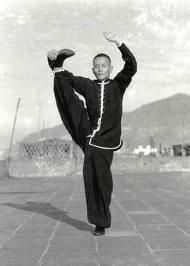
History of Eagle Claw
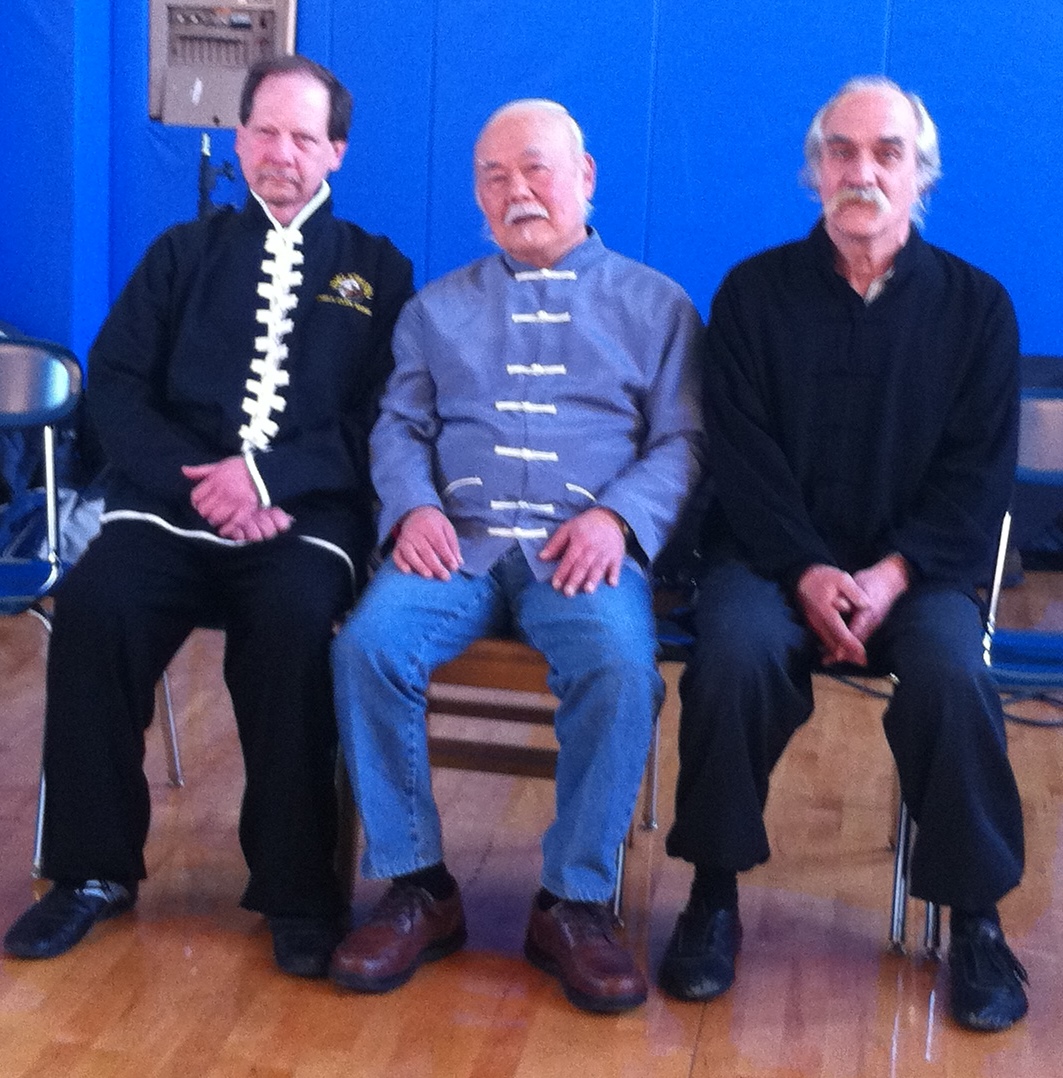
The Eagle Claw System can be traced back to the end of the Southern Sung Dynasty (about 1250 AD.) At this time, under the rule of King Go Chung, China was being invaded by the Mongolian “Golden Soldiers.” The Sung general in charge of resistance to the “Golden Soldiers” was Ngok Fei. Training his soldiers in fighting techniques he had learned from a Sil Lum monk named Jow Tong, Ngok Fei continuously defeated the Mongolian invaders and, on several occasions, almost succeeded in capturing their general. As a result, Ngok Fei and his fighting techniques acquired a reputation throughout China. The fighting techniques of Ngok Fei had a well-deserved reputation. Known as the “108 Fighting Techniques,” they were primarily a system of hand techniques refined and perfected by Ngok Fei. Varying from simple blocking and punching to more complicated grappling, these techniques emphasized grabbing, locking, and pressure point strikes. These techniques, which are still taught today as “Lin Kuen,” made Ngok Fei a well-respected man during his lifetime.
While Ngok Fei was earning his reputation as a great general, the Sung King enjoyed a life of leisure. He had delegated much of his authority to his Prime Minister, Chun Koy, who was neither moral nor patriotic. He continuously advised the king to cease all hostilities with the Mongolians to further his interests and recall Ngok Fei. After a time, he succeeded, and Ngok Fei returned to find that he had been discredited in the eyes of the king. A short time later, Ngok Fei died, either executed or by suicide; no one is sure.
Upon Ngok Fei's death, his soldiers, in anger, left the king's service. However, some of these soldiers continued to practice the 108 Fighting Techniques while wandering all over China. In this way, the system survived the political and social upheavals of 13th-century China until it eventually returned to the monastery, where it underwent its greatest change.
The Creation of Faan Tzi Ying Jow Pai
Ngok Fei’s 108 Fighting Techniques returned to the monastery where they had begun with the monk Jow Tong years before. They were practiced and passed on to succeeding generations in the same form as Ngok Fei had developed them. But then, sometime during the Ming Dynasty (1368 – 1644), the system changed dramatically.
At that time, the Eagle Claw System, which consisted solely of the 108 Techniques, was revealed to a monk named Lai Chin. Lai Chin, a great master of the system known as Faan Tzi, was very impressed with the Eagle Claw techniques. So he decided to combine the two systems to complement each other and thus form a single, smooth, effective Kung Fu system. Lai Chin spent years on this task. First, he had to master the 108 Techniques of Eagle Claw. Then, he had to find the weak points of both systems and combine them to form one stronger and more effective system than either could be alone. Finally, Lai Chin succeeded in his task and named the new system Faan Tzi Ying Jow Pai.
Lai Chin is one of the most prominent figures in the history of the Eagle Claw System. His development of Faan Tzi Ying Jow Pai is the Northern Eagle Claw system. Combining the original 108 Techniques of Ngok Fei with established Faan Tzi forms, Lai Chin created the system that is still practiced today in the same way he developed it.
For his part in developing Faan Tzi Ying Jow Pail, Lai Chin became a prominent member of the kung fu society of his day. The system continued to be practiced and passed on, and its later history contains the names of many men, some of whom would become famous in their own time.
Chan Tzi Ching
Chan Tzi Ching was one of the most famous Eagle Claw masters, earning quite a reputation as a fighter. He fought successfully throughout China, never using more than three techniques to defeat an opponent. His strength was also incredible; he developed his strength to such an extent that he could get his full power in a three-inch punch.
Upon receiving the Eagle Claw System from Lau Shing Yuo, Chan Tzi Ching began teaching in southern China. While teaching in a place called Ching Hoy Yin, he was approached by a Kung Fu master named Fawk Yung Gop, who invited him to help in creating a Kung Fu association. This was the beginning of the Ching Mo Association. Soon after being approached by Fawk Yun Gop, Chan Tzi Ching went to Shanghai to establish the first Ching Mo gymnasium. He taught Eagle Claw there and soon had more students than he could teach alone. So he returned to his village and selected some of Lau Kai Man’s students to train as assistants. These students were Lau Chi Cheung, Lau Jim Ng, Lau Yimp Cheung, Lau Fat Mon, Cheung Jim Man, Yui Kin Wah, and Lee Bo Ying. One of these, Lau Fat Mon, had already received the system from his uncle, Lau Kai Man. These students traveled to the Association in Shanghai, where they were trained in the 10 primary Ching Mo forms.
By 1924, two more Ching Mo gymnasiums had been established, one in Hong Kong under Chan Tzi Ching and one in Fat Sen, where Lau Fat Mon was now teaching. But in 1929, Chan Tzi Ching had to return to his village at the request of his family. So before leaving Hong Kong, he sent Lau Fat Mon to teach in his place. There were many students at the Hong Kong school, some of whom were deeply interested in the system. Among these students were Ng Wai Nung, Lo Yuen Kun, Lee Chop Ming, and Law Wai Chiu.
Eagle Claw from the 1930s to the Present
In 1931, Lau Fat Mon accepted an invitation to teach Kung Fu in the village of Wong Jong in Gong Moon. With two of his students, Ng Wai Nung and Yui Kin Wah, he established a Ching Mo gymnasium in the village. Though the village was small, about 5,000 people, there were some 300 students, and the school was well furnished. About six months after the school opened, there was a festival in the village, including the first public demonstration of Eagle Claw. Ng Wai Nung and Yui Kin Wah performed many sets with flips and splits. The audience applauded vigorously. Then, Sifu Lau gave an exceptional performance based on Jui Kao Tong (the special Eagle Claw
Drunken Set).
Both hands were claws — one seemingly holding a wine bottle and one a cup. Using natural mimicry, Sifu Lau staggered about like a drunken eagle. Suddenly, he would fall flat on his back, but like magic, he would pop up onto his feet. Then he would fall flat on his side and, twirling his legs like wings, spring up again. The techniques of the Eagle Claw Drunken Form are in the secrets of falling, rolling, hopping, jumping, and springing, and the great Lau Fat Mon amazed all with the inner strength he demonstrated. The audience could see that his movements were both smooth and powerful. When he finished, the applause was like thunder.
But this success proved provocative to the southern-style Kung Fu men of the village, who were also watching. Later, these jealous men became more verbally aggressive and loud in the tea house where the Eagle Claw men were celebrating. A hothead behind Ng Wai Nung’s chair tried to punch him, but Ng Wai Nung caught the motion out of the corner of his eye. He blocked the punch with one hand and palmed him in the waist so hard that he tumbled backward across the tea house. The other men ran out, and respect for Ng Wai Nung rose. However, when this news returned to Lau Fat Mon, he punished Ng Wai Nung and Yui Kin Wah.
Three years later, Lau Fat Mon left the village and returned to Hong Kong at the invitation of the Jong Nam Sports Association. With him went Ng Wai Nung; Yuin Kin Wah remained in the village to teach. When he arrived, his old Ching Mo students joined him at Jong Nam, and the new school became very crowded.
Ng Wai Nung had been following Lau Fat Mon for over a decade at this time, and so even though Lau Fat Mon was very busy, he found time to teach him the deepest secrets of Eagle Fist. Part of these were the three master forms, Jui Lao Tong (Eagle Claw Drunken Set), Fuk Fu Kuen (Control the Tiger Fist), and Lin Kuen (Connected Fist), also called “Long Form,” in honor of its extraordinary length. Lau Fat Mon acknowledged Ng Wai Nung’s successorship by culminating his ten years of training with these treasures of the Eagle Claw System, without which the system is incomplete. In addition, Ng Wai Nung also completed the Wu Style Tai Chi System under Chui Sau Chun and Lau Bing Hun, two famous sifus.
In 1936, Lau Fat Mon was offered a commission as a colonel if he would teach Eagle Claw in the army. He accepted the offer and stayed in the military during the Japanese bombings of Canton and until the Japanese surrender. He then returned to Canton and took a position as senator, holding that office until the coming of Mao Tse Tung. Lau Fat Mon then returned to Hong Kong, where he continued teaching Eagle Claw at his school. Lau Fat Mon died of a heart attack on March 17, 1964. During his life, he helped to bring the Eagle Claw System to Southern China.
Ng Wai Nung taught at the school of Lau Fat Mon until 1942. At that time, as Hong Kong was about to become involved in the Second World War, he returned to his village. Upon arriving, he began teaching Kung Fu in three different villages.
At each of his schools, demonstrations and lion dances were performed, making the name Ng Wai Nung very popular in that area. Ng Wai Nung would perform a unique set at demonstrations, “Fuk Fu Kuen” (Control the Tiger). This very high form explicitly uses chi to connect the movements. It requires perfect control of power because the techniques are fast and suddenly slow, slow and suddenly fast. It is hard and then soft at one time — true Ying and Yang power. Fuk Fu Kuen is a form taught to masters only. He would also perform “Say Moon Dai Do” (Four Doors Great Knife), a Kwan Do set, with such power and skill that he reminded people of the Kung Fu god Kwan Wan Cheung.
In 1949, Ng Wai Nung returned to Hong Kong, where he remained teaching Eagle Claw and Tai Chi for the next seven years. At this time, some of his advanced students were Shum Dak Chiu, Shum Man Lock, Shum Yui Ching, Ho Wai Man, and Shum Leung.
In 1956, Ng Wai Nung went to Singapore at the invitation of the Singapore Ching Mo Association. A sifu was needed there who could teach both Northern Style Kung Fu and Tai Chi, and, at the suggestion of the manager of the Hong Kong Association, Chan Kung Jit, Ng Wai Ng was called on. After a while, he returned to his school in Hong Kong, which he had left in the care of Shum Man Lock and Shum Leung. He found it very crowded when he returned to the school on Yee Chow Street. So he moved the school to Tai Nam Street and then to Tai Po Road, where the school still is. He remained teaching at the Hong Kong school until just recently. Now 80 years old, Ng Wai Nung has turned the school over to his two sons, Ng Quan Pok and Ng Quan. During his life, Ng Wai Nung has done more to spread the Eagle Claw System than anyone else.
Ng Wai Nung had several serious students who wished to master the Eagle Claw System. One of these was Shum Leung, his godson. Shum Leung began learning kung fu at eight and would practice every morning for three hours starting at six. Ng Wai Nung took a close interest in his godson's instruction, and in the 20 years of his study, Shum Leung learned the secrets of Eagle Claw and Wu Style Tai Chi Chuan.
In 1972, Sifu Shum left Hong Kong and came to America to spread the Eagle Claw System. He opened a school in New York City and soon had many students of different backgrounds. In the few years he has taught here, he has become well-known for judging tournaments and performing demonstrations in New York, Boston, Puerto Rico, and Washington D.C. Sifu Shum has also served as the Eastern U.S. Kung Fu Federation treasurer.
Welcome New Members
Leo Castillo
Autumn Folweiler
Andrew McVicker
Christine Erfman
Noah Charles
Linda Benson
James Gerdes
Cassian Salsbury
Cameron Vactor
Kelly Baur
Andrea Maroni
Milton Rodgers
Ada Dolan
Rao Angara
Nila Sharon
Mark Goodman
Anastasia Le
Leanna Zinkand
Dominick Pekarovich
Darnell Jones
Kio Farrish-Allen
Mendel Bassman
Jenny Marze
Karen Denne
Katori Wolfe
Logan Lanz
Lori Hatala
Tommy Exacustides
Lucas Exacustides
Joe Nebinski
Sophie Nebinski
Jayce Nebinski
Sonya Binus
Beth Shuler
Don Shuler
Sydnee Moretti
Robin Moretti
Lisa Binus
Ben Binus
Joey Furka
Linda Fox
Evelyn Furka
Bill Russell
Copyright © Rothrock's Kung Fu & Tai Chi. All Rights Reserved
